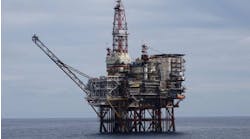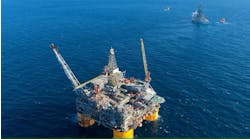Sequential process ideal for Dolphin partners
Jeremy BeckmanFloating production, storage, and offloading (FPSO) vessels have fallen out of favor of late in the North Sea, due to a series of late deliveries and contractual disputes. The resultant cost overruns have confounded the purpose of this technology, especially when applied to marginal fields.
Editor, Europe
A team of venturers new to the UK sector, however, is working on an approach which would involve rapid development and depletion of a number of fields in quick succession, using a leased floating system. Their aim is low risk, low cost production, hopefully coinciding with an oil price upturn.
Partners in this alliance, known as the "Dolphin Project," are Petrobras (UK), the license operator, and two Canadian companies - Bow Valley Energy and Morrison Middlefield Resources. Calgary-based Bow Valley is a new company striving to build a global production mix, initially from the North Sea. Petrobras is working from new offices in London. Like other state oil concerns (e.g. NIOC) which have seen their national oil monopoly ended, Petrobras is having to seek out new opportunities. It identified the North Sea as a suitable starting point for its expertise, particularly in FPSOs.
North Sea startup
The Dolphin partners' first purchase went through early this year, when they acquired BP's stakes in five central North Sea blocks. That package included four undeveloped discoveries, all under consideration for extended well tests (EWTs) to determine the scope for full-scale field development.Ettrick, tentatively unitized across UK blocks 20/2a and 20/3a, is rated as a 35 million bbl oil prospect. The field was discovered in 1981 from a Jurassic horizon well. Blane is on the UK/ Norway median line in block 30/3a. Reserves are estimated at 30 million bbl.
The four fields acquired were in BP's view non-core, low reserve volume properties. They were selected by the Dolphin partners from a short-list of 35 undeveloped North Sea discoveries. Currently, the partners are talking to other operators in the sector about tying further finds into this project.
Earlier this year, the alliance invited tenders for extended well facilities and project management of a series of EWTs on the Dolphin-owned assets. The plan at present is to drill a single development well, or recompletion of an existing wellbore, into the candidate field's primary reservoirs, followed by extended production tests, each lasting up to six months. Production data gleaned would be used to assess the optimum development configuration for the field.
Under a second, full production phase, the vessel would switch to floating production mode to drain the field's reservoirs before moving onto the next Dolphin-owned field for another EWT, followed by FPSO duty, and so on.
Minimal liability
Once the vessel has moved onto the second field, the plan is to re-use the subsea wellheads, flowlines and mooring system. That would leave well shut-ins as the only significant abandonment liability. Fred Olsen is the contractor designated to provide the FEED for the FPSO, which will probably not be selected until late 1999.By entering into long-term leases for production systems, the Dolphin partners expect to cut costs substantially, compared with those for a typical single-lease project. The selected contractors would also operate their facilities. However, as Stu Colburne, Bow Valley's Vice President, Exploration, acknowledges there has to be some fluidity in the scheduling, particularly if a third party-owned field comes into the equation. "The operator may say, OK, Dolphin, we'll take your EWT facility, but we want the option to produce even for three years'. We have to be flexible enough to respond.'"
Production from a Dolphin-owned field is not expected before 2000, and the sequential development plans may have to be suspended if the oil price remains low. As for recent FPSO cost overruns, the Dolphin partners have been keeping a watchful eye on events, Colburne says, and are working on innovative ways of putting together contracts to counter this situation.
Another possible candidate could be Premier's 18 million bbl Chestnut Field in UK block 22/20, discovered in 1986, in which Bow Valley has a 17.75% interest. The British operator is known to be keen to initiate a development, but has been thwarted so far in its attempts to find a suitable production facility.
Copyright 1998 Oil & Gas Journal. All Rights Reserved.


